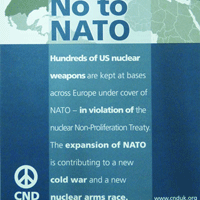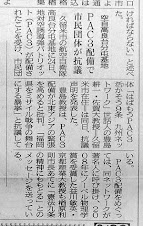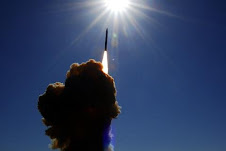* Text fwd by Bruce Gagnon on March 23, 2011
Wired
Suicidal cousins of drones lead attack on Gaddafi
By Noah Shachtman
March 22, 2011
When the US military wanted to take out Muammar Gaddafi's air defense systems, it unleashed a barrage of 122 Tomahawk cruise missiles. But these munitions aren't like most others in the American arsenal.
Smart, maneuverable, able to see its surroundings and shift to new targets mid-flight, the newest Tomahawks are closer to the unmanned planes flying over Afghanistan than to the weapons they fire. In some ways, the Tomahawk is the drone's suicidal cousin: a robotic aircraft, packed with explosives, that has no intention of ever coming home.
When officers get ready to shoot off a Tomahawk, "they are basically planning a flight for a little aeroplane," one Navy official tells Danger Room. "It's got stubby little wings -- but is is an unmanned aerial vehicle."
The next-gen Tomahawks -- known as "Block IVs" -- start their flights out just like other missiles, launched from {Aegis destroyer] ships or subs. But after 12 seconds of flight, things change. The Tomahawk starts to fly horizontally, skimming above the ocean at a height of less than 15 metres to avoid enemy radar.
GPS waypoints keep the missile on track until it makes landfall. Then, a Tercom (Terrain Contour Matching) system kicks in. too. Using a radar altimeter, the Tomahawk Tercom checks its height, and matches that altitude against a database of satellite and overhead imagery, to make sure the missile is headed in the right direction and at the right height.
Once the Tomahawk's target is in sight, the missile can dart in for the attack. A Digital Scene-Mapping Area Correlator ("dee-smack" in military jargon) matches a stored picture of the target to the missile's last sight, to make sure the two match.
Or, the missile can wait a while. The Tomahawk's controller can give it a new route, telling the Tomahawk to circle around in the air, lingering until an enemy pops up its head. Then comes the strike.
In May 2010, the Tomahawk demonstrated a new move, as Sam LaGrone from Jane's Defence Weekly reported at the time. The Los Angeles-class submarine USS Cheyenne fired off a Block IV at a target in the Mojave Desert.
Meanwhile, a team from Naval Special Warfare Group 3 shot a second set of co-ordinates to the Tomahawk's controllers in Japan, nearly 5,000 miles away. They reprogrammed the missile via satellite, and sent the Tomahawk crashing into a new target. (In an earlier test (.pdf), special operations forces were able to use the pictures taken from a handheld Raven drone to direct its bigger, more destructive relative to its end.)
Cruise missiles have been around in one form or another since World War II, and Tomahawks have been schwacking American enemies since the days of Desert Storm. Some earlier models had nuclear warheads. Others (still in service) employ cluster-bombs, much to the chagrin of human rights groups, who aren't keen on how the minimunitions can linger on a battlefield long after a war is over.
From the outside, the Block IVs look much like their predecessors: a little over six metres long, and about 1500kg. Like the older models, they're still expensive, too -- at about £670,000 a pop, the initial assault on Libya chewed through £82 million in missile costs alone. They can fly for about two hours or 1,000 miles, whichever comes first.
However, that could radically change if an experimental Air Force program pans out. The X-51a aircraft is designed to test technologies for a next-gen cruise missile -- one that would fly at six times the speed of sound. Which means tomorrow's cruise missiles could be like suicidal, smart, and more than eight times faster than today's Tomahawks.
Global Network Against Weapons & Nuclear Power in Space
PO Box 652
Brunswick, ME 04011
(207) 443-9502
globalnet@mindspring.com
www.space4peace.org
http://space4peace.blogspot.com/ (blog)
Thank God men cannot fly, and lay waste the sky as well as the earth. ~Henry David Thoreau
Subscribe to:
Post Comments (Atom)

![[URGENT PLEA: In Update] EMERGENCY in GANGJEONG Since AUG. 24, 2011](http://2.bp.blogspot.com/-3iz8k-USXVY/TlmRYhhIYtI/AAAAAAAAL2c/9dbF85ZIkIs/s227/jejusit.jpg)



![[Solidarity from Japan for the Jeju] 253 individuals and 16 groups/organizations](http://2.bp.blogspot.com/_gnM5QlRx-4c/TR_YeNVE1yI/AAAAAAAAHWQ/ARyf6oQN0S0/S227/jeju_12_10j.jpg)

![[Translation] Korean organizations' statement: Immediately cancel the joint ROK-US drill Nov 26](http://2.bp.blogspot.com/_gnM5QlRx-4c/TPOE8VKXHFI/AAAAAAAAGlM/8lryt-8sFjc/S227/1.jpg)
![HOT! [Hankyoreh Hani TV] Beneath the Surface: the investigation into the sinking of the Cheonan](http://4.bp.blogspot.com/_gnM5QlRx-4c/TOI83qht8aI/AAAAAAAAGXU/22SW6Q5ntV8/S227/HaniTV%2BCheonan.gif)



![[Translation]Statement against illegal inspection and unjust lay-off by the Kunsan USAFK!(Nov_2010)](http://4.bp.blogspot.com/_gnM5QlRx-4c/TOPLsVkZMqI/AAAAAAAAGZs/3YnnckIyAaY/S227/gunsan%2Bprotest.gif)
![[Translation] Korean organizations' statement against dispatching special force to the UAE on Nov.](http://4.bp.blogspot.com/_gnM5QlRx-4c/TOP95zHXlCI/AAAAAAAAGak/E0Ug1XtUFfM/S227/antiwarpeace.jpg)
![[Translation] Stop, Joining MD!: South Korean activists' statement and writing on Oct. 25, 2010](http://3.bp.blogspot.com/_gnM5QlRx-4c/TOP7Es4_2sI/AAAAAAAAGac/eWVMPD-U4p0/S227/StopMD.jpg)
![[In Update] People First, NO G-20 (Nov. 6 to 12, Korea)](http://2.bp.blogspot.com/_gnM5QlRx-4c/TJd53XBzHlI/AAAAAAAAFQo/ldO9JPE3eqo/S227/left21_G20.jpg)
![[International Petition] Stop US helipad plan in Okinawa to save great nature](http://4.bp.blogspot.com/_gnM5QlRx-4c/TKC2AHRNzBI/AAAAAAAAFUo/yGWXODTw_uM/S227/yanbaru_w.jpg)

![[Global Network] against the first launch of Quasi-Zenith Satellite, Japan, on Sept. 11, 2010](http://4.bp.blogspot.com/_gnM5QlRx-4c/TIowa1boy4I/AAAAAAAAFDI/82rAi98uq-c/S227/Qzss-45-0_09.jpg)

![[In update] Some collections on the Koreans’ protests against the sanction & war on Iran](http://4.bp.blogspot.com/_gnM5QlRx-4c/TJMvke6t8zI/AAAAAAAAFO4/tamQ8LUnOOA/S227/No+Sanction+on+Iran.jpg)
![[Three International Petitions] to End the Korean war and peace treaty(or peace resolution)](http://1.bp.blogspot.com/_gnM5QlRx-4c/THef7bzWxYI/AAAAAAAAE44/wwdzSDfYhdw/S227/border.jpg)



![[Collection of Documents] No Base Learning and Solidarity Program_Korea(June 14 to 20, 2010)](http://1.bp.blogspot.com/_gnM5QlRx-4c/TCTvVuN8NeI/AAAAAAAAEek/8vBJVaHdk10/S227/No-Base-banner.jpg)
![Site Fwd:[John Hines] A U.S. Debate coach’s research trip on the Issues of Korea](http://3.bp.blogspot.com/_gnM5QlRx-4c/TINCO36mzzI/AAAAAAAAE_w/Rds12NcBOXM/S227/Jeju-Peace-Tour.jpg)


![[News Update] Struggle Against the Jeju Naval Base since Jan. 18, 2010](http://1.bp.blogspot.com/_gnM5QlRx-4c/S1vvWaP25uI/AAAAAAAACkg/QvpW1tgOlKM/S226/scrum1.jpg)


![[Urgent] Please spread the Letter!: There was no Explosion! There was no Torpedo! (May 26, 2010)](http://4.bp.blogspot.com/_gnM5QlRx-4c/S_9JmsKEU7I/AAAAAAAAEP8/sAWjSPqxzUI/S227/grounded.jpg)
![Text Fwd: [Stephen Gowans]The sinking of the Cheonan: Another Gulf of Tonkin incident](http://1.bp.blogspot.com/_gnM5QlRx-4c/TAL_FtYKQ-I/AAAAAAAAERE/NEEMijiEcRM/S227/lee-myung-bak.jpg)
![[Japan Focus]Politics in Command: The "International" Investigation into the Sinking of the Cheonan](http://1.bp.blogspot.com/_gnM5QlRx-4c/TBMJ2syJzyI/AAAAAAAAEZU/uTYZccU5vyk/S227/wen_jiabao_and_lee_myungbak.png)
![[Japan Focus] Who Sank the SK Warship Cheonan? A New Stage in the US-Korean War and US-China](http://2.bp.blogspot.com/_gnM5QlRx-4c/S_iQ2vE5ZpI/AAAAAAAAEOU/Oo1SPcAe8FE/S227/buoy_map.gif)
![[Updated on 12/13/10] [Translation Project] Overseas Proofs on the Damages by the Military Bases](http://4.bp.blogspot.com/_gnM5QlRx-4c/S-qSj59gPLI/AAAAAAAAEGM/mwjlFtPE-jo/S227/missile.jpg)
![[International Petition] Close the Bases in Okinawa](http://3.bp.blogspot.com/_gnM5QlRx-4c/S8-z3DYNwNI/AAAAAAAADo4/OswTSchK09M/S227/2.jpg)

![[In Update]Blog Collection: No Korean Troops in Afghanistan](http://4.bp.blogspot.com/_gnM5QlRx-4c/SwnlLD9IewI/AAAAAAAAB9E/oUPssnpNidA/S226/No-Troops-to--Afghanistan.jpg)











No comments:
Post a Comment